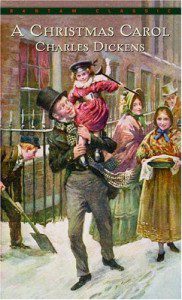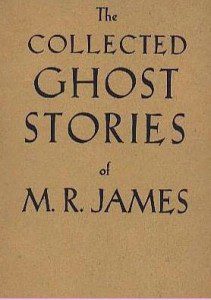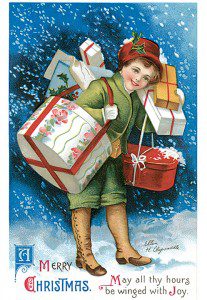 Mention the words ‘Christmas ghost story’, and most people will automatically think of A Christmas Carol by Charles Dickens. Indeed, it has become the quintessential example of the subgenre, having been animated several times (one of the most notable was the Oscar-winning version by Richard Harris and produced by Chuck Jones [Looney Tunes, etc.], and featuring Alistair Sims as the voice of Scrooge) and also filmed many, many times (and yet again Alistair Sims’ rendition being rated as one of the best adaptations). However, this wasn’t the only Christmas ghost tale that he wrote, in fact he wrote five seasonal books altogether: A Christmas Carol came first in 1843, followed by The Chimes (1844), The Cricket on the Hearth (1845), The Battle of Life (1846) and The Haunted Man (1848), and there was also a short story The Signalman, published as part of the Mugby Junction collection in the 1866 Christmas edition of All Year Round (this story was also filmed in 1976 for the BBC’s Ghost Story for Christmas, starring Denholm Elliott [Dr. Marcus Brody in the Indiana Jones films]).
Mention the words ‘Christmas ghost story’, and most people will automatically think of A Christmas Carol by Charles Dickens. Indeed, it has become the quintessential example of the subgenre, having been animated several times (one of the most notable was the Oscar-winning version by Richard Harris and produced by Chuck Jones [Looney Tunes, etc.], and featuring Alistair Sims as the voice of Scrooge) and also filmed many, many times (and yet again Alistair Sims’ rendition being rated as one of the best adaptations). However, this wasn’t the only Christmas ghost tale that he wrote, in fact he wrote five seasonal books altogether: A Christmas Carol came first in 1843, followed by The Chimes (1844), The Cricket on the Hearth (1845), The Battle of Life (1846) and The Haunted Man (1848), and there was also a short story The Signalman, published as part of the Mugby Junction collection in the 1866 Christmas edition of All Year Round (this story was also filmed in 1976 for the BBC’s Ghost Story for Christmas, starring Denholm Elliott [Dr. Marcus Brody in the Indiana Jones films]).
Christmas isn’t just about Dickens
But Dickens wasn’t the only one who was wont to write seasonal tales of this sort. We have to be thankful to Christmas for the ghostly tales that the master of supernatural fiction, MR James, left to us in several collections. All of the Provost’s ghost stories were written for telling in his candlelit Eton lodgings on Christmas Eve, to a select few of his friends. In fact, the image that this conjures inevitably epitomises the typical picture that we have of the Victorian Christmas tradition of telling ghost stories – a warm room, heated by a roaring log fire in the grate and bathed in the soft glow of candles, with a small gathering of rapt listeners focusing their fullest attention on the master of the house standing by the fireplace, reading aloud. Outside the window, in the sharply cold winter night, there may have been a pale frosty moon in the sky, the light from it reflecting off the glistening layer of snow blanketing all. Is it any wonder then, with this atmospheric tableau clearly pictured in our minds, that the telling of ghost stories was so apt for such an occasion.
 It makes a lot of sense, when you stop to think about it. Midwinter is the point at which the world turns away from hibernation and looks forward to brighter days ahead, with the daylight subtly lengthening gradually, encouraging life and nature to begin to stir once more into activity. It wouldn’t be that much of a leap of imagination to suppose that the dead are at their most active and powerful at this time, just before the sun’s return to the heights of spring and summer, and therefore nearest to those still living. Many of the Christmas traditions we take for granted, the Christmas tree and Santa Claus himself for instance, were introduced and bequeathed to us by the Victorians, and many of those traditions had their roots in pagan custom. I would surmise that the telling of ghost stories around a fire had parallel origins, harking back perhaps to a time when tales of dead ancestors and their illustrious exploits were told around campfires at a similar time of the year.
It makes a lot of sense, when you stop to think about it. Midwinter is the point at which the world turns away from hibernation and looks forward to brighter days ahead, with the daylight subtly lengthening gradually, encouraging life and nature to begin to stir once more into activity. It wouldn’t be that much of a leap of imagination to suppose that the dead are at their most active and powerful at this time, just before the sun’s return to the heights of spring and summer, and therefore nearest to those still living. Many of the Christmas traditions we take for granted, the Christmas tree and Santa Claus himself for instance, were introduced and bequeathed to us by the Victorians, and many of those traditions had their roots in pagan custom. I would surmise that the telling of ghost stories around a fire had parallel origins, harking back perhaps to a time when tales of dead ancestors and their illustrious exploits were told around campfires at a similar time of the year.
A Victorian Christmas
The Victorians, at Christmas or otherwise, were apparently very enamoured of the ghost story, and there was a huge flowering of such supernatural fiction during the era. Most of the famous literary names from the period produced such stories in addition to those they’re better known for – writers such as Rudyard Kipling (The Jungle Book), Sir Arthur Conan Doyle (Sherlock Holmes), Elizabeth Gaskell (Cranford) and Edith Nesbit (The Railway Children) all produced tales to chill the marrow. Remember, too, that the Victorian era saw the fads that were spiritualism, séances, ectoplasm and table-rapping gain popularity, and it also gave us organisations such as Madame Blavatsky’s Theosophical Society as well as the Golden Dawn (amongst whose members were the Irish poet WB Yeats and the infamous Aleister Crowley [the creator of Simon Iff, a mystic-magician-philosopher-psychoanalyst-detective character who very much represented the prevailing zeitgeist of the times]). This was also a time of uncertainty, what with many hitherto eternal spiritual verities making way for scientific discoveries in all fields and from all corners of the globe. Is it any wonder then that people sought remedies to those uncertainties, turning to the supernatural and belief in the dead being able to communicate with the living as a means of coping?
 I see the popularity of the ghost story in Victorian times as another manifestation of the response to those uncertainties – that and the very human thrill of being scared out of one’s wits for the fun of it, of course. And most certainly, the Victorians went for it in a big way. Periodicals, magazines, penny-dreadfuls and annuals published ghost stories throughout the year, but the form appeared to reach its apotheosis at the Yule-tide festivities. After all, family gatherings would provide the perfect audience at such a special time, plus supernatural tales appealed to both the young and the old. And no matter how frightening, the evening’s scares could be dispelled simply by a bright light or the good-natured laughter of the storyteller at tale’s end.
I see the popularity of the ghost story in Victorian times as another manifestation of the response to those uncertainties – that and the very human thrill of being scared out of one’s wits for the fun of it, of course. And most certainly, the Victorians went for it in a big way. Periodicals, magazines, penny-dreadfuls and annuals published ghost stories throughout the year, but the form appeared to reach its apotheosis at the Yule-tide festivities. After all, family gatherings would provide the perfect audience at such a special time, plus supernatural tales appealed to both the young and the old. And no matter how frightening, the evening’s scares could be dispelled simply by a bright light or the good-natured laughter of the storyteller at tale’s end.
There was probably another side to it as well – a way of remembering those who were no longer there to join in the communal and familial celebrations. A reassurance, perhaps, that even though they may no longer be with them physically, their spirits lived on and were watching over them. A reminder too, perhaps, of the transient nature of life, that the journey from birth to death is an ephemeral one. No doubt in addition there was also a moral dimension to the telling of the stories, a way of impressing people that they must lead good, wholesome lives (and, coming full circle, a good example of such a moralistic tale would be Dickens’ A Christmas Carol, with its emphasis on Christian charity and concern for our fellow man), otherwise they would never achieve the peace in death that was the ambition of every Victorian.
(As an aside, the Victorians were also fascinated by death, unsurprisingly, creating modern concepts of mourning and memorialisation – but that’s a story for another time…).
The most important aspect of all this, however, is that the Victorians, for all their sometimes over-bearing sentimentality, gave us the ghost story (and by extension the currently popular horror genre) as our inheritance. All of our favourite genre authors owe them a debt, be it a conscious or unconscious influence. We forget at our peril how something as simple as getting spectral chills on Christmas Eve would bring the family together as a unit. In these days of ubiquitous non-stop 24-hour entertainment available to all at the flick of a switch, in the form of games, videos, television and the internet, the notion of family members gathering around a homely fire to listen to someone tell them a ghostly tale appears both nostalgic and eminently appealing – wouldn’t it be great to see the return of such a wonderful tradition!
SIMON MARSHALL-JONES









